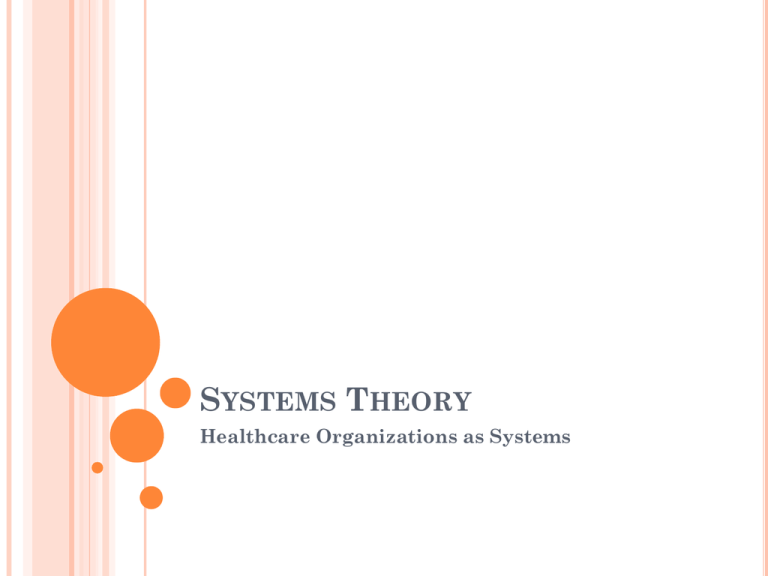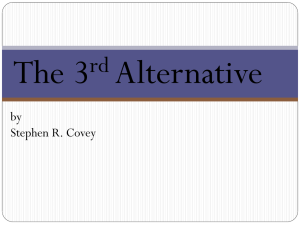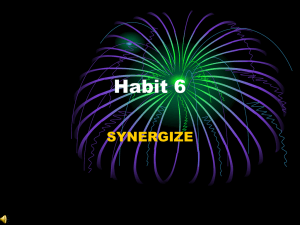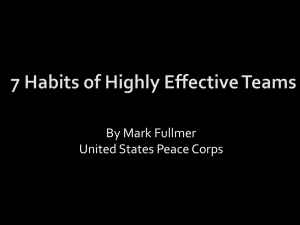Systems Theory ppt
advertisement

SYSTEMS THEORY Healthcare Organizations as Systems CENTRAL IDEA A central topic of systems theory is selfregulating systems, i.e. systems self-correcting through feedback. Self-regulating systems are found in nature, including the physiological systems of our body, in local and global ecosystems, and in climate—and in human learning processes (from the individual on up through international organizations like the UN).[(Wikipedia) ORGANIZATIONAL SYSTEMS Synergy Interdependence Interconnections within the organization between the organization and the environment Organization as ORGANISM “A set of elements standing in inter-relations” GENERAL THEORETICAL DISTINCTIONS Classical and humanistic theories prescribe organizational behavior, organizational structure or managerial practice (prediction and control). MACHINE Systems theory provides an analytical framework for viewing an organization in general (description and explanation). ORGANISM WEAKNESSES Doesn’t focus on specific task functions Doesn’t directly explore the impact of interpersonal relationships and loyalty on productivity Doesn’t provide for detailed focus Changes in environment directly affect the structure and function of the organization. STRENGTHS Recognizes ... interdependence of personnel impact of environment on organizational structure and function affect of outside stakeholders on the organization Focuses on environment and how changes can impact the organization Seeks to explain “synergy” & “interdependence” Broadens the theoretical lens for viewing organizational behavior MORE STRENGTHS Designed to deal with complexity Attempts to do so with precision Takes a holistic view It is a theory of emergents - actions and outcomes at the collective level emerge from the actions and interactions of the individuals that make up the collective PRINCIPLES OF GENERAL SYSTEMS THEORY Laws that govern biological open systems can be applied to systems of any form. Open-Systems Theory Principles Parts that make up the system are interrelated. Health of overall system is contingent on subsystem functioning. Open systems import and export material from and to the environment. Permeable boundaries (materials can pass through) Relative openness (system can regulate permeability) Second Principle of Thermodynamics (ENTROPY) Entropy must increase to a maximum Negentropy increases growth and a state of survival Synergy (extra energy causes nonsummativity--whole is greater than sum of parts) Equifinality vs. “one best way.” CHARACTERISTICS OF ORGANIZATIONS AS SYSTEMS McMillan & Northern (1995) on Enabling Co-dependency Asymmetrical communication status of the hierarchy The socially acceptable addiction Money and power as distractions Focus on ends instead of means Skilled communication incompetence Workaholics Addiction leads to more co-dependency The organization’s selective attention Levels of authority Fear of Punishment Deprived of useful feedback Emotion is masked First extension of Systems Theory into Management Practice - CONTINGENCY THEORY CONTINGENCY THEORY There is no one best way to structure and manage organizations. Structure and management are contingent on the nature of the environment in which the organization is situated. Argues for “finding the best communication structure under a given set of environmental circumstances.” Management of Innovation - Burns and Stalker (1968) 2 CONTINGENCY THEORIES Burns and Stalker (1968) Management of Innovation Organizational systems should vary based on the level of stability in the environment Two different types of management systems Mechanistic systems - appropriate for stable environment Organic systems - required in changing environments (unstable conditions) Management is the Dependent Variable Variations in environmental factors lead to management Lawrence and Lorsch (1969) Key Issue is environmental uncertainty and information flow Focus on exploring and improving the organization’s relationship with the environment Environment is characterized along a certaintyuncertainty continuum PRAGMATIC APPLICATION OF SYSTEMS THEORY The Learning Organization Peter Senge’s The Fifth Discipline: The Art and Practice of the Learning Organization (1990) An organization that is continually expanding its capacity to create its future Organizational Learning Occurs under Two Conditions 1) When design of organizational action matches the intended outcome 2) When initial mismatch between intentions and outcomes is corrected, resulting in a match Key attribute of learning organization is increased adaptability Adaptability is increased by advancing from adaptive to generative learning THE LEARNING ORGANIZATION Adaptive (single-loop) Learning Involves coping with a situation Limited by the scope of current organizational assumptions Occurs when a mismatch between action and outcome is corrected without changing the underlying values of the system that enabled the mismatch. Generative (double-loop) Learning Moves from COPING to CREATING an improved organizational reality Necessary for eventual survival of the organization Both are Central Features of the Model of the Communicative Organization (Chapter 6) Synergy and Nonsummativity are Important THE LEARNING ORGANIZATION, CONTINUED Through communication, teams are able to learn more than individuals operating alone. Critics argue that teams inhibit learning Thoughts? Leadership is a key element in creating and sustaining a learning organization. Leaders are responsible for promoting an atmosphere conducive to learning CREATIVE TENSION Represents difference between the “vision” of where the organization could be and the reality of the current organizational situation. IMPEDIMENTS TO THE LEARNING ORGANIZATION Complexity of the Environment Internal Conflicts Difficult to determine cause and effect Multiple contributing elements in complex environments Individuals, teams, departments, and subcultures are often at odds Energy is drained by conflict Organization members must be trained in communication and conflict-negotiation skills SUMMARY Systems Theory is NOT a prescriptive management theory Attempts to widen lens through which we examine and understand organizational behavior The Learning Organization Synergy Nonsummativity Interdependence Equifinality Requisite Variety Emphasizes COMMUNICATION in the Learning Process Organizations cannot separate from their environment Organizational teams or subsystems cannot operate in isolation BOTTOM LINE: The same misunderstandings and problems that continue to occur will eventually cause fatal damage to the system KEY TERMS: INPUT OUTPUT STASIS HOMEOSTASIS Interdependence www.slideshare.net/PhilVincent1/fourframe-model







